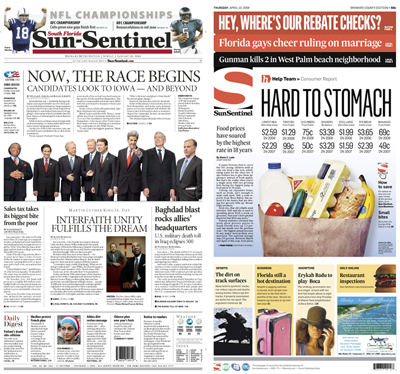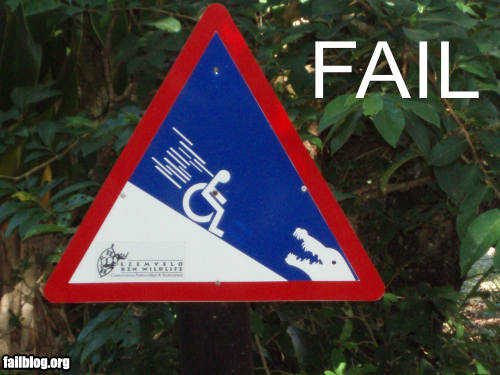Conde Nast Portfolio takes a look at Tribune Co.’s much ballyhooed redesigns and finds that nothing much has changed. New looks-and-feels in Orlando and Ft. Lauderdale have barely budged circulation, which continues to fall. “We can’t find any impact from the redesign,” Norbert Ortiz, the Orlando Sentinel‘s vice president for circulation and consumer marketing, tells Portfolio.
This doesn’t bode well for recent makeovers in Los Angeles and Chicago. Experts debate whether the new designs are radical or just a new coat of paint, with the painters holding the edge: “a distraction,” says Ken Doctor; “seat of the pants” adds Alan Mutter. The story focuses on Tribune chief innovation officer Lee Abrams, who is inexplicably pictured with the cast of Blue Man Group. Abrams invented the album format that revolutionized FM radio back in the 80s, but his innovations in print have been less dramatic. “I wouldn’t call it redesign. I would call it redecoration,” says Alan Jacobson of Brass Tacks Design.
Abrams is quoted asserting that “we really had to work on reclaiming things that newspapers had traditionally owned,” from investigative reporting to election and crime coverage. Oddly, Tribune Co. has slashed editorial staff at most of its papers this year, drastically undercutting their ability to sustain provide such information.
We’ve previously shared our opinion of redesigns (“A Useless Exercise at the Wrong Time”) and see no further need to comment.
New/Old Journalism Clash in Washington Park
Mediashift tell of a new online publication at New York University that’s challenging the school’s 36-year-old campus fixture, Washington Square News (WSN). The venture was launched by three non-journalism majors who were frustrated with what they call WSN’s bland tone and faux objectivity. NYU Local, which is currently configured as a blog, takes a fundamentally different view of impartiality. “Most people who want to be objective tend to disguise their opinions,” says co-editor Lily Quateman says. “Being objective treats readers like idiots and makes them guess.”
WSN Editor-in-Chief, Adam Playford begs to differ, saying his journal will continue to report just the facts and label opinions accordingly. He also says online isn’t a major focus at WSN, which updates its website just once a day. In contract, NYU Local encourages anyone to contribute and makes it possible to do so by any means possible, including cell phone. The staff hopes to move to a social networking platform in order to further encourage community journalism. “The idea of citizen journalism is a massive misnomer,” says 20-year-old co-editor Cody Brown. “Everyone is a citizen and anyone can be a reporter. The term is patronizing.”
The piece, which is written by an NYU junior, highlights the push-pull taking place between old- and new-media models, even within the context of a college-age audience. The fundamental debate is over the question of whether professional reporters are better equipped to tell a story versus thousands of unknown citizens. The fact that the battle is taking place in an institution that’s training the next generation of journalists indicates that this issue will be debated for some time to come.
Layoff Log
- More layoffs are days away at the Baltimore Sun, according to the newspaper’s union. If true, the action would follow by just five months a 100-person downsizing this summer, a cutback that hit the newsroom particularly hard. No word on numbers, but the cuts are expected to be layoffs, not buyouts. The Sun employed 1,400 people before the 100-person cutback last June.
- With five more newsroom layoffs at the New Haven Register, the size of the newsroom staff will have shrunk from 110 to 65 in a decade. The five editors are part of a larger cutback of 20 people announced yesterday. The daily will also shutter Play, an entertainment-oriented weekly. More layoffs are possible in mid-January, when parent Journal Register may fall into default if it can’t make its debt payments. Earlier this week, Journal Register said it would probably close two small Connecticut dailies – the New Britain Herald and the Bristol Press – along with 11 weeklies in the state.
- As expected, the ax has fallen in Tribune Co.’s Washington bureaus. LA Observed reports that Chicago Tribune staffers John Crewdson, Bay Fang, Stephen Hedges, and Aamer Madhani were let go. Earlier eight Los Angeles Times staffers were laid off and acting Tribune acting bureau chief Naftali Bendavid left to join The Wall Street Journal.
- Newhouse is cutting deeply in Michigan. Staff at eight newspapers have been told that massive buyouts are planned and some operations will be consolidated in Grand Rapids and Kalamazoo. There’s no word on numbers, but the Ann Arbor Chronicle account says nearly everyone in the newsroom has been offered a buyout. Production staff has been told that if they don’t take the buyout, they’ll have to work from the Grand Rapids office, which is 130 miles away. Papers in the group include the Grand Rapids Press, Ann Arbor News, Jackson Citizen Patriot, Flint Journal, Bay City Times, Muskegon Chronicle, Saginaw News and the Michigan Business Review. The Ann Arbor paper early announced plans to close its Ypsilanti bureau and to slash pages and sections in an effort to control costs.
Miscellany
Outsell’s Ken Doctor has some encouraging news for newspapers. “It’s a shrinking business that only looks like it is dying,” he tells Media Life. “The U.S. newspaper business will still take in some $40 billion in revenues in 2008.” Doctor believes some papers will close and many may scale back frequency in coming years in order to align expenses with smaller revenues. However, he expects the business to come back, even the devastated classified advertising business. “Forty percent of the newspaper industry is partnering with Yahoo, and we should see a good Yahoo bump in online display ads,” Doctor says. A lot of retraining will be needed, though.
Preliminary research by Middleberg & Associates and the Society of New Communications Research shows that 100% of reporters under 30 agree that new media and communication tools are valuable journalism tools. But only 40% of journalists over 50 year agree with that statement. There is no more change-averse animal than an old newsman. You can still take the survey here.
The Daily Triplicate of Crescent City, Calif. celebrates awards from the California Newspaper Publishers Association by trashing the slipshod tactics most awards programs use to select winners. Its tone might sound a bit snarky, but our experience is that the point is valid.
In case you didn’t see this comment from last week, journalism professor Robert Hodierne at the University of Richmond has been commissioned by American Journalism Review “to survey folks who left the newspaper business under circumstances other than voluntary — laid off, bought out, etc. I’m spreading the word about this survey in every way I can and if you guys could help me spread the word I’d be grateful. Take the survey here.
Newspaper Death Watch editor Paul Gillin is interviewed on The Radio Ecoshock Show about what’s ailing newspapers and what will fill the gap. You can skip the description and listen to the short interview here.


![John McIntyre McIntyre [cq]](http://www.newspaperdeathwatch.com/wp-content/uploads/2008/09/mcintyre.jpg)




